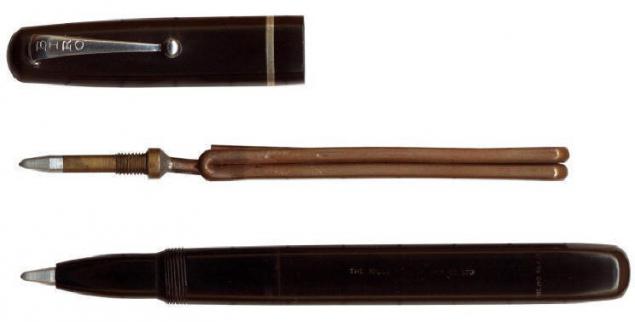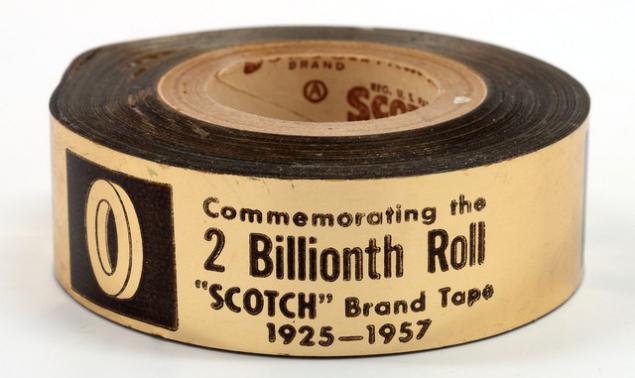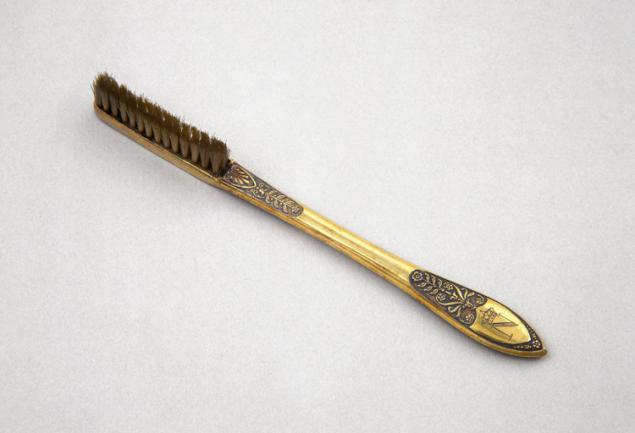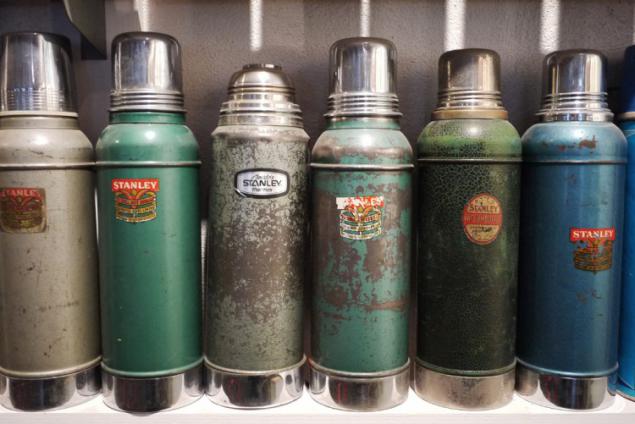13 The first copies of things without which you can not imagine your life!
 Bashny.Net
Bashny.Net
We are so used to those around us in everyday life things, it seems as if they have always been, and without them is impossible to manage. However, they once were first invented, then constructed the first time. Let's see how looked the first or one of the first instances of these things.
The first digital camera.
In 1975, engineer Steven Sasson worked at the Kodak created the first digital camera based on CCD production Fairchild. The camera weighed about three kilograms and allows you to record images of 100 × 100 pixels (0, 01 megapixels) to tape Compact Cassette. One frame is recorded 23 seconds.

The first medical syringe.
Despite the fact that intravenous injections were carried out from the middle of the XVII century, a syringe, in the form in which we know it today, was invented in 1853 by a veterinarian Charles Gabriel Pravasi and Alexander Wood independently.
The first syringes were made of a rubber cylinder, which was placed inside a well-fitting piston leather and asbestos with protruding metal sleeve bridged. At the other end of the cylinder strengthened hollow needle. Since the cylinder is opaque, notches for dispensing medication is not on it, and on the metal pin of the piston.

The first ballpoint pen.
Modern ballpoint pen invented by Hungarian journalist Laszlo Biro in 1931 (patented in 1938). In Argentina, where he lived for many years a journalist, these pens are called after him, "Byrom».

The first remote control.
The first wireless remote control designed in 1956 by Austrian-born American Robert Adler. Control was mechanical and used ultrasound to define the channel and volume. When the user clicks the button, it clicked and hit the plate. Each plate was pulled noise of different frequencies and patterns of the TV recognize this noise.

The first Scotch tape.
Despite its widespread Russian name "Scotch" (from the English scotch - Scots, Scottish), the first tape was not invented in Scotland, or Scottish. She came up with a German pharmacist Troplovits Oscar in 1901, while working at the company Beiersdorf AG. He called it leucoplasts and intended it to protect the skin lesions. Leucoplasts production began in 1921. Initially, the adhesive is applied only on the edges of the tape. For Americans it is called the first adhesive tape, produced by Dick Drew in 1925, "scotch" due to widespread legends of Scottish stinginess.

The first modern soap.
In itself, the soap was known in ancient Sumer and Babylon. However, the first mass production of soap under the name Ivory Soap established company Procter & Gamble in 1879. After a lot of experimentation in 1878 James Gamble finally found a convenient formula for the manufacture of white soap industrial way. At the end of October 1879 the first soap Ivory Soap was sold for 10 cents.

The first chemical match.
The first match made in 1805, the French chemist Jean Chancel. It had wooden matches, ignited by contact of the head of a mixture of sulfur, potassium chlorate and cinnabar with concentrated sulfuric acid. In 1813, Vienna was registered first in Austria-Hungary match-manufacture Maliarda and Vic for the production of chemical matches. By the time the production sernikov (sulfur matches) (1826), British chemist and druggist John Walker chemical matches were already quite widespread in Europe.

The first toothbrush.
The world's first toothbrush was invented in ancient Islamic world, many years ago, but it was not the toothbrush we use today in our daily lives. In those days dentifrice used with a special root disinfectant properties.
The present production of ancestors of modern toothbrushes launched in 1780 by Englishman William Edis. The first patent for toothbrush was awarded the American Uodsvorfom in 1850, although production in the United States emerged only by 1885. These brushes are equipped with a handle made of bone, while they themselves were made of brush bristles of the Siberian wild boar. (As it turned out, this is not the best material for the brush, as it dried up a long time and it could be got harmful bacteria).

The first bag.
The American inventor Allen Breed created a key component for the use of airbags in cars - ball sensor for collision detection. He presented his invention in 1967 by Chrysler. While Americans rarely used seat belts and this innovation that helps protect passengers not buckled in the event of a frontal collision, it has been in great demand. The first sample of the airbag in a production car was introduced in 1972, when he was released Oldsmobile Toronado, model 1973.

The first safety razor.
King Gillette in 1901, was the first who offered the world a safety razor. A prerequisite for this was the normal domestic situation, when King blunted razor blade. To sharpen it, it was necessary to go to the hairdresser, and time, of course, it was not.
In addition, Gillette has offered a completely different design razor. Blade he gripped between the two plates so that were exposed only to the outside the two edges. The handle was attached separately - perpendicular to the blade. But success does not just come to the King. He had no technical education, but because it took years to find an engineer to agree to such an experiment.

The first thermos.
Thermos - is not the only thing, the invention is not an end in itself, but it turned out as a side effect. James Dewar studied the problem of long-term storage of liquefied gases - nitrogen, oxygen, hydrogen. Dewar produced his own vessel in a flask with a narrow neck. To improve the thermal insulation of the inside of the bulb covered with a thin layer of a scientist silver. So in 1898 he received the design that the grateful physics still called Dewar. German Reinhold Berger quickly realized that this opening can be drawn considerable commercial benefit. In 1904, he launched a company for the production of "vacuum flask", adding Dewar lid and a glass-sealed cork. Thus the Berlin manufacturer of glass instruments became the creator of the world's thermos.

The first canned food.
In the late 18th century, mankind (or rather its worthy representative Nicolas François Appert) opened the delights of conservation, and the problem is much simpler. Initially, they were glass jars with fruit puree, broth, soup, which the government has implemented its Napoleonic soldiers in the long march. Received for his opening title gooder, Upper opened shop in Paris, where he successfully sold various victuals in sealed bottles and boxes. Later, he even wrote a book about the methods of conservation.

The first digital camera.
In 1975, engineer Steven Sasson worked at the Kodak created the first digital camera based on CCD production Fairchild. The camera weighed about three kilograms and allows you to record images of 100 × 100 pixels (0, 01 megapixels) to tape Compact Cassette. One frame is recorded 23 seconds.

The first medical syringe.
Despite the fact that intravenous injections were carried out from the middle of the XVII century, a syringe, in the form in which we know it today, was invented in 1853 by a veterinarian Charles Gabriel Pravasi and Alexander Wood independently.
The first syringes were made of a rubber cylinder, which was placed inside a well-fitting piston leather and asbestos with protruding metal sleeve bridged. At the other end of the cylinder strengthened hollow needle. Since the cylinder is opaque, notches for dispensing medication is not on it, and on the metal pin of the piston.

The first ballpoint pen.
Modern ballpoint pen invented by Hungarian journalist Laszlo Biro in 1931 (patented in 1938). In Argentina, where he lived for many years a journalist, these pens are called after him, "Byrom».

The first remote control.
The first wireless remote control designed in 1956 by Austrian-born American Robert Adler. Control was mechanical and used ultrasound to define the channel and volume. When the user clicks the button, it clicked and hit the plate. Each plate was pulled noise of different frequencies and patterns of the TV recognize this noise.

The first Scotch tape.
Despite its widespread Russian name "Scotch" (from the English scotch - Scots, Scottish), the first tape was not invented in Scotland, or Scottish. She came up with a German pharmacist Troplovits Oscar in 1901, while working at the company Beiersdorf AG. He called it leucoplasts and intended it to protect the skin lesions. Leucoplasts production began in 1921. Initially, the adhesive is applied only on the edges of the tape. For Americans it is called the first adhesive tape, produced by Dick Drew in 1925, "scotch" due to widespread legends of Scottish stinginess.

The first modern soap.
In itself, the soap was known in ancient Sumer and Babylon. However, the first mass production of soap under the name Ivory Soap established company Procter & Gamble in 1879. After a lot of experimentation in 1878 James Gamble finally found a convenient formula for the manufacture of white soap industrial way. At the end of October 1879 the first soap Ivory Soap was sold for 10 cents.

The first chemical match.
The first match made in 1805, the French chemist Jean Chancel. It had wooden matches, ignited by contact of the head of a mixture of sulfur, potassium chlorate and cinnabar with concentrated sulfuric acid. In 1813, Vienna was registered first in Austria-Hungary match-manufacture Maliarda and Vic for the production of chemical matches. By the time the production sernikov (sulfur matches) (1826), British chemist and druggist John Walker chemical matches were already quite widespread in Europe.

The first toothbrush.
The world's first toothbrush was invented in ancient Islamic world, many years ago, but it was not the toothbrush we use today in our daily lives. In those days dentifrice used with a special root disinfectant properties.
The present production of ancestors of modern toothbrushes launched in 1780 by Englishman William Edis. The first patent for toothbrush was awarded the American Uodsvorfom in 1850, although production in the United States emerged only by 1885. These brushes are equipped with a handle made of bone, while they themselves were made of brush bristles of the Siberian wild boar. (As it turned out, this is not the best material for the brush, as it dried up a long time and it could be got harmful bacteria).

The first bag.
The American inventor Allen Breed created a key component for the use of airbags in cars - ball sensor for collision detection. He presented his invention in 1967 by Chrysler. While Americans rarely used seat belts and this innovation that helps protect passengers not buckled in the event of a frontal collision, it has been in great demand. The first sample of the airbag in a production car was introduced in 1972, when he was released Oldsmobile Toronado, model 1973.

The first safety razor.
King Gillette in 1901, was the first who offered the world a safety razor. A prerequisite for this was the normal domestic situation, when King blunted razor blade. To sharpen it, it was necessary to go to the hairdresser, and time, of course, it was not.
In addition, Gillette has offered a completely different design razor. Blade he gripped between the two plates so that were exposed only to the outside the two edges. The handle was attached separately - perpendicular to the blade. But success does not just come to the King. He had no technical education, but because it took years to find an engineer to agree to such an experiment.

The first thermos.
Thermos - is not the only thing, the invention is not an end in itself, but it turned out as a side effect. James Dewar studied the problem of long-term storage of liquefied gases - nitrogen, oxygen, hydrogen. Dewar produced his own vessel in a flask with a narrow neck. To improve the thermal insulation of the inside of the bulb covered with a thin layer of a scientist silver. So in 1898 he received the design that the grateful physics still called Dewar. German Reinhold Berger quickly realized that this opening can be drawn considerable commercial benefit. In 1904, he launched a company for the production of "vacuum flask", adding Dewar lid and a glass-sealed cork. Thus the Berlin manufacturer of glass instruments became the creator of the world's thermos.

The first canned food.
In the late 18th century, mankind (or rather its worthy representative Nicolas François Appert) opened the delights of conservation, and the problem is much simpler. Initially, they were glass jars with fruit puree, broth, soup, which the government has implemented its Napoleonic soldiers in the long march. Received for his opening title gooder, Upper opened shop in Paris, where he successfully sold various victuals in sealed bottles and boxes. Later, he even wrote a book about the methods of conservation.

Tags
See also
5 things that should be remembered for those who want to achieve great heights!
THINGS TO BE AWARE every man
20 depressing things that we learned in 2015
18 things for which you do not have to apologize
10 of the most ordinary things, the origin of which is discouraging
9 things that are worth investing in
Dakota Fanning: about his personal life and about what movies she would like to shoot
13 things urgently need to get rid of!
British style

















